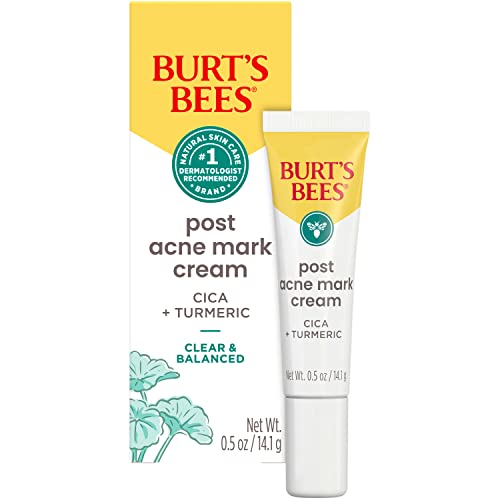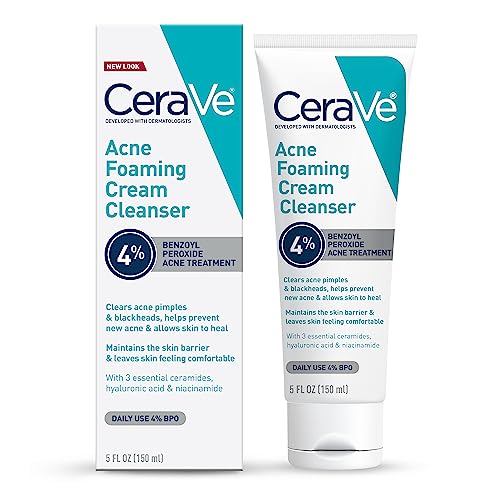
How to speed up the healing process of acne scars with spot treatment?
Learn how to speed up the healing process of acne scars with spot treatment in this step-by-step guide. Discover effective methods to minimize their appearance and promote faster healing.
Effective Solutions for Acne Scars



Cleanse your face
- Wet your face: Begin by splashing some lukewarm water on your face to moisten the skin and prepare it for cleansing.
- Squeeze out the cleanser: Take a small amount of gentle cleanser onto your fingertips or palm. Use about a dime-sized amount, or adjust according to the instructions on the product.
- Apply the cleanser: Gently massage the cleanser onto your face using circular motions. Start from the center of your face and work your way outwards, covering your entire face, including the forehead, nose, cheeks, and chin. Be sure to avoid the delicate eye area.
- Cleanse thoroughly: Spend a few moments massaging the cleanser into your skin. This will help to loosen any dirt, oil, or makeup that might be trapped within your pores. Pay extra attention to areas that tend to be oilier or more prone to breakouts.
- Rinse off: Splash your face with lukewarm water to rinse off the cleanser. Make sure to remove all traces of the cleanser to avoid clogged pores or residue on your skin.
- Pat dry: Gently pat your face dry with a clean towel. Avoid rubbing your skin, as this can cause irritation or redness.
By following these simple steps, you can effectively cleanse your face, removing any impurities and preparing your skin for further treatment. Remember to choose a gentle cleanser suitable for your skin type and to cleanse your face twice daily for optimal results.



Choose a spot treatment product
Selecting a spot treatment product specifically designed for acne scars is crucial for effective results. When choosing a product, look for active ingredients like salicylic acid or benzoyl peroxide. These ingredients are known for their exfoliating properties, which help to remove dead skin cells and promote skin cell turnover. Additionally, they work to reduce inflammation and redness associated with acne scars. To find the right product, consider the following:
- Read the ingredient list: Look for products that contain salicylic acid or benzoyl peroxide as the main active ingredient.
- Check for concentration: Ensure that the product has a sufficient concentration of the active ingredient to provide effective results.
- Consider your skin type: If you have sensitive skin, opt for products that are formulated to be gentle and less likely to cause irritation.
- Patch test: Before applying the spot treatment all over your face, do a patch test on a small area of your skin to check for any adverse reactions.
- Follow the instructions: Read and follow the instructions provided with the product carefully, as different spot treatments may have specific application techniques.
By selecting a spot treatment product with the right ingredients and following the proper application instructions, you can effectively target acne scars and achieve a smoother, clearer complexion.



Apply the spot treatment
Apply the spot treatment by first ensuring that your fingertip or cotton swab is clean. Then, take a small amount of the spot treatment and directly apply it onto the acne scars. For example, if you are using a cotton swab, dip it into the product and dab it onto the affected areas. If you prefer using your fingertip, gently scoop up a small amount of the spot treatment and dot it onto the scars. Once the product is applied, it’s time to gently massage it into the skin. Use circular motions to massage the spot treatment into the scars, ensuring that it is fully absorbed. Take your time and be gentle to avoid any irritation. Continue massaging until the product has completely penetrated the skin.



Avoid picking or popping
- Resist the urge to pick or pop your acne scars. Picking or popping acne scars may be tempting, but it can actually hinder the healing process and result in more noticeable scarring. Remember to exercise self-control and avoid touching your scars.
- Keep your hands away from your face. Prevent any unnecessary irritation by refraining from touching your face with your hands. Touching your face can transfer bacteria and dirt, leading to breakouts and potential infection. Keep your hands busy with other activities to distract yourself from the urge to touch your scars.



Protect your skin
- Choose a broad-spectrum sunscreen: Look for a sunscreen that provides broad-spectrum protection, which means it protects against both UVA and UVB rays. This will ensure that your skin is shielded from the full range of harmful UV radiation.
- Opt for SPF 30 or higher: Select a sunscreen with a sun protection factor (SPF) of 30 or higher. This will offer better protection against the sun’s damaging rays. Higher SPF values provide increased defense, but SPF 30 is the minimum recommended for adequate protection.
- Apply generously: Ensure you apply enough sunscreen to cover all exposed areas of your skin. Use about one ounce (a palmful) of sunscreen for your entire body. Don’t forget to apply it to commonly missed areas like the ears, back of the neck, and tops of the feet.
- Reapply as needed: Sunscreen wears off over time, so it’s crucial to reapply it every two hours or more frequently if you’re sweating or swimming. Even water-resistant sunscreens can lose their effectiveness, so be diligent about reapplication.
- Use sunscreen every day: Don’t reserve sunscreen for sunny days only. UV rays can penetrate clouds and windows, so it’s important to wear sunscreen every day, regardless of the weather or if you’re indoors. Protecting your skin consistently will help prevent sun damage and darkening of acne scars.
By following these steps and making sunscreen a part of your daily routine, you can effectively protect your skin from harmful UV rays and minimize the potential for acne scars to darken or heal slowly.



Be consistent and patient
Consistency is key when it comes to spot treatment. Apply the product directly to the affected area according to the instructions provided. Ensure that you are using the product consistently, without skipping any applications. Remember, results may not be immediate, so be patient. It may take several weeks or even months to see significant improvement. In the meantime, maintain a healthy skincare routine by cleansing, exfoliating, and moisturizing regularly. Additionally, adopting a healthy lifestyle, including drinking plenty of water, getting enough sleep, and eating a balanced diet, will contribute to optimal results. Stick to your routine, stay patient, and you will gradually notice the desired improvements.
Effective Solutions for Acne Scars
In conclusion, spot treatment is an effective tool in accelerating the healing process of acne scars. By adopting a comprehensive skincare routine and adhering to the tips mentioned in this blog post, individuals can successfully minimize the appearance of scars and achieve a clearer, more radiant complexion. Consistency and patience are key, but with the right approach, you can see significant improvements in your skin’s appearance over time.
Necessary Supplies






Effective Spot Treatments
Application process for spot treatment of acne scars
- Cleanse your face thoroughly before applying the spot treatment
- Gently pat dry your face with a clean towel
- Take a small amount of the spot treatment and apply it directly onto the acne scars
- Massage the spot treatment into the scars using gentle circular motions
- Leave the spot treatment on for the recommended duration mentioned on the product packaging
- Avoid touching or picking at the treated area to allow the spot treatment to work effectively
- Follow the instructions provided by the spot treatment product for best results
- Use the spot treatment regularly, as directed, to see noticeable improvements in the appearance of acne scars
Frequently Asked Questions about Spot Treatment for Acne Scars
How does spot treatment help in reducing the appearance of acne scars?
Spot treatment can help reduce the appearance of acne scars by targeting the specific areas where scars are present. Most spot treatments contain ingredients such as salicylic acid, benzoyl peroxide, or retinoids, which help to exfoliate the skin and promote cell turnover. These ingredients can help to unclog pores, reduce inflammation, and fade pigmentation, all of which contribute to the visibility of acne scars. By applying spot treatment directly to the affected areas, it allows for a concentrated application of these ingredients, increasing their efficacy in reducing the appearance of scars over time. It is important to note that spot treatment may not completely eliminate severe or deep acne scars, but it can help to improve their overall appearance.
Are there any specific guidelines or instructions for using spot treatment for acne scars?
Yes, there are specific guidelines and instructions for using spot treatment for acne scars. Here are some general guidelines that are commonly recommended:
- Cleanse your face: Start by cleansing your face with a mild cleanser to remove any dirt, oil, or makeup. Pat your skin dry before applying the spot treatment.
- Follow the product instructions: Read and follow the instructions provided by the specific spot treatment you are using. Different products may have different application methods and usage frequency.
- Spot test: Before applying the spot treatment all over your face, it is advisable to do a patch test on a small area of your skin to check for any adverse reactions or sensitivity.
- Apply a thin layer: Take a small amount of the spot treatment and apply it directly on the acne scars or spots. Use a clean finger or a cotton swab to gently dab the product onto the affected areas.
- Avoid excessive use: It is important not to overapply the spot treatment as it may cause skin irritation or dryness. Follow the recommended usage instructions and avoid using more product than necessary.
- Allow absorption time: Give the spot treatment enough time to absorb into your skin. Avoid touching or rubbing the treated areas until the product is fully absorbed.
- Moisturize: After the spot treatment has dried, apply a moisturizer suitable for your skin type. This helps to maintain the skin’s hydration and minimize any potential dryness caused by the spot treatment.
- Sun protection: It is crucial to protect your skin from the sun, especially when using spot treatments. Apply a broad-spectrum sunscreen with at least SPF 30 before going outside, as some spot treatments may increase sun sensitivity.

Hey, I’m Ava Wilson—a skincare enthusiast and a certified esthetician. I’m dedicated to sharing my knowledge and empowering others to achieve healthy, glowing skin through simple, effective routines and natural remedies. Join me on this exciting skincare journey, and let’s unlock your skin’s potential for a confident, beautiful you.





